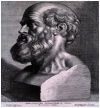Five thousand years of minimal access surgery: 3000BC to 1850: early instruments for viewing body cavities
- PMID: 33135953
- PMCID: PMC7816654
- DOI: 10.1177/0141076820967913
Five thousand years of minimal access surgery: 3000BC to 1850: early instruments for viewing body cavities
Abstract
Surgeons and their patients recognise that one of the major advances in surgical technique over the last 20 years has been the growth of minimal access surgery by means of laparoscopic and robotic approaches. Partnerships with industry have facilitated the development of advanced technical instruments, light sources, recording devices and optics which are almost out of date by the time they are introduced to surgical practice. However, lest we think that technological innovation is entirely a modern concept, we should remember that our predecessors were masters of their craft and able to apply new technologies to surgical practice. The history of minimal access surgery can be traced back to approximately 5000 years ago and this review aims to remind us of the achievements of historical doctors and engineers, as well as bring more modern developments to wider attention.This review will comprise a three-part series:Part I 3000BC to 1850 Early instruments for viewing body cavitiesPart II 1850 to 1990 Technological developmentsPart III 1990 to present Organisational issues and the rise of the robots.
Keywords: Surgery; general surgery; history of medicine.
Figures





Comment in
-
Letter to the Editor: Five thousand years of minimal access surgery.J R Soc Med. 2021 May;114(5):234. doi: 10.1177/0141076821992465. Epub 2021 Feb 10. J R Soc Med. 2021. PMID: 33565915 Free PMC article. No abstract available.
Similar articles
-
Five thousand years of minimal access surgery: 1990-present: organisational issues and the rise of the robots.J R Soc Med. 2021 Feb;114(2):69-76. doi: 10.1177/0141076820967907. Epub 2020 Nov 2. J R Soc Med. 2021. PMID: 33135951 Free PMC article.
-
Five thousand years of minimal access surgery: 1850 to 1990: Technological developments.J R Soc Med. 2021 Jan;114(1):19-29. doi: 10.1177/0141076820967918. Epub 2020 Nov 2. J R Soc Med. 2021. PMID: 33135950 Free PMC article.
-
A short history of robotic surgery.Ann R Coll Surg Engl. 2018 May;100(6_sup):5-7. doi: 10.1308/rcsann.supp1.5. Ann R Coll Surg Engl. 2018. PMID: 29717892 Free PMC article. Review.
-
[History of minimally invasive surgery].Med Pregl. 2009 Nov-Dec;62(11-12):597-602. Med Pregl. 2009. PMID: 20491389 Serbian.
-
The History of Neurosurgical Spinal Oncology: From Inception to Modern-Day Practices.World Neurosurg. 2021 Jun;150:101-109. doi: 10.1016/j.wneu.2021.03.082. Epub 2021 Mar 23. World Neurosurg. 2021. PMID: 33771747 Review.
Cited by
-
Minimal Invasive Procedures in Strabismus Surgery: A Narrative Review.J Curr Ophthalmol. 2023 Dec 21;35(2):105-109. doi: 10.4103/joco.joco_24_23. eCollection 2023 Apr-Jun. J Curr Ophthalmol. 2023. PMID: 38250492 Free PMC article. Review.
-
Application of a highly simulated and adaptable training system in the laparoscopic training course for surgical residents: Experience from a high-volume teaching hospital in China.Heliyon. 2023 Feb 2;9(2):e13317. doi: 10.1016/j.heliyon.2023.e13317. eCollection 2023 Feb. Heliyon. 2023. PMID: 36825174 Free PMC article.
-
Minimally invasive surgery: a historical and legal perspective on technological transformation.J Robot Surg. 2025 Jul 21;19(1):408. doi: 10.1007/s11701-025-02589-7. J Robot Surg. 2025. PMID: 40691391 Free PMC article. Review.
-
Scoping out the past: meniscus examination with arthroscopy; the light arrived in the knee before the end of World War I with the cystoscope, Fresnel's lens, and Edison's lamp.Int Orthop. 2023 Oct;47(10):2601-2614. doi: 10.1007/s00264-023-05940-5. Epub 2023 Aug 22. Int Orthop. 2023. PMID: 37606766
-
Five thousand years of minimal access surgery: 1990-present: organisational issues and the rise of the robots.J R Soc Med. 2021 Feb;114(2):69-76. doi: 10.1177/0141076820967907. Epub 2020 Nov 2. J R Soc Med. 2021. PMID: 33135951 Free PMC article.
References
-
- Mattelaer JJ, Billiet I. Catheters and sounds: the history of bladder catheterisation. Paraplegia 1995; 33: 429–433. - PubMed
-
- Sakkara Doctor Tomb Unearthed, www.jayepurplewolf.com/LEGENDS/sakkaradoctortomb.html, 2001.
-
- Driver GR, Miles JC. Codex Hammurabi. Babylonian Laws 1955; Vol. 2Oxford: Clarendon Press.
-
- Kocher F. Die Babylonisch-Assyrische Medizin. Texten und Untersuchungen 1963–1980; Vol. 6Berlin: De Gruyter.
Publication types
MeSH terms
LinkOut - more resources
Full Text Sources

